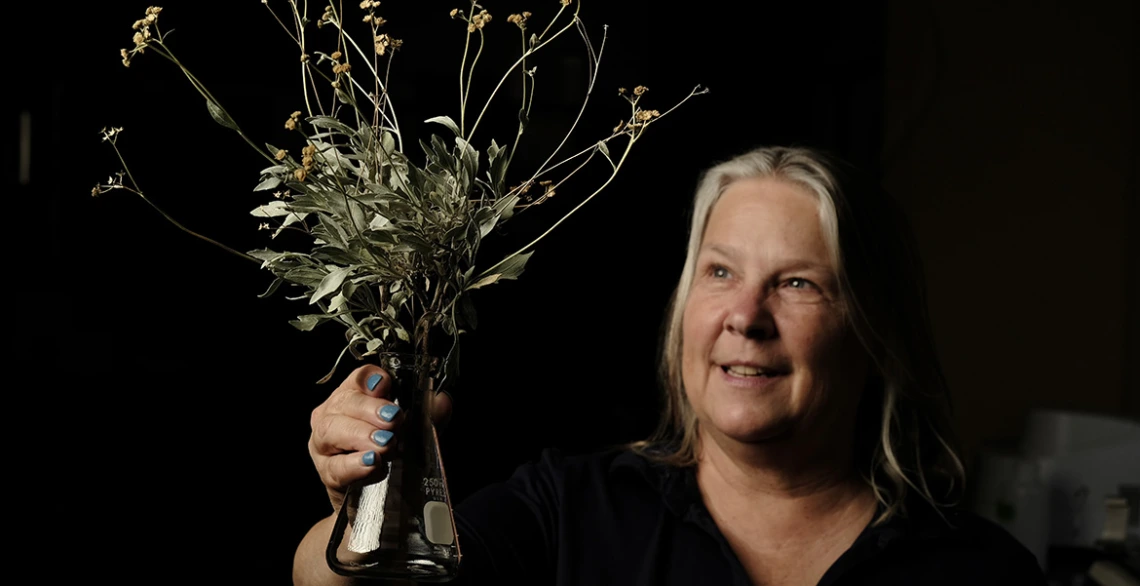UA Engineers Lead $70M Project to Turn Desert Shrub Into Rubber
Guayule is a sustainable crop with the potential to provide a reliable domestic rubber source.

Researcher Kim Ogden holds up branches from a guayule shrub, a plant with the potential to provide a reliable domestic rubber source.
University of Arizona researchers are teaming up with Bridgestone Americas Inc. to develop a new variety of natural rubber from a source that is more sustainable and can be grown in the forbidding conditions of the arid Southwest.
Kim Ogden, head of the Department of Chemical and Environmental Engineering, is principal investigator on a $70 million, five-year project focused on growing and processing guayule (pronounced why-OO-lee), a hardy, perennial shrub that could be an alternative source of natural rubber.
The U.S. Department of Agriculture granted $35 million for the project, with an equal match from Bridgestone, the tire and rubber company, to help growers transition to guayule crops from their traditional rotations of hay, cotton and wheat.
Additional partners on the project include the Colorado River Indian Tribes, Colorado State University, regional growers and OpenET, a public-private partnership that facilitates responsible water management.
Bridgestone has been working with guayule in Arizona since 2012 at the company's 280-acre farm in Eloy, about halfway between Phoenix and Tucson. Bridgestone plans to expand the farm to 20,000 acres in the next several years by working with Native American farmers to grow guayule on tribal lands, and with other area farmers.
"Eventually, we hope to have plantings of around 100,000 acres, spread out across 15 or 20 facilities across the Southwest," said David Dierig, section manager for agro operations at Bridgestone.
Why Guayule?
Rubber is currently sourced from a single species – Hevea brasilensis, or the para rubber tree –grown almost exclusively in Southeast Asia.
Having a single source for rubber globally means the supply of this critical material can be precarious and subject to market volatility. The para rubber tree crop is susceptible to disease, particularly leaf fall disease. In addition, the price of rubber is affected by increasing labor costs, and there is the potential for geopolitical disorder, Ogden said.
"There is a big risk, as well as supply chain problems, when you have all the natural rubber coming from one region of the world," Ogden said. "The goal for Bridgestone and for the other tire companies is to find reliable, domestic sources of rubber."
Scientists have had their eyes on guayule as a rubber producer for over a century, Dierig said. The shrub, which matures in just two years, is native to the Chihuahuan Desert in northern Mexico and southern New Mexico.
"People had looked at this plant as far back as World War I, and during World War II there was a ton of research because our rubber supply got cut off," Dierig said.
The Emergency Rubber Act, passed by Congress in 1942, directed scientists to find alternative sources for rubber, and guayule was in the mix.
"They probably had around 30,000 acres of it planted here in Arizona, and they found a lot of facets to it that were advantageous," Dierig said.
Interest in guayule eventually faded, and the para rubber tree remained the sole source of industrial rubber. While synthetic rubber – a material derived from petroleum – is suitable for limited uses, it does not have the resilience of natural rubber and cannot be used in the most demanding products, such as airplane tires or tires for large agricultural vehicles, so the need for a new rubber source has become increasingly pressing.
"Reducing the amount of rubber we are importing from Southeast Asia is also going to help with biodiversity and climate change," Dierig said.
Climate- and Market-Smart Solution
The grant will fund the development and refinement of growing guayule with climate-smart practices, Ogden said.
"We want to use less water, install irrigation systems to avoid flood irrigation, use less fertilizer and educate the growers," she said. "If you're looking at a big system life-cycle assessment, this is going to cut down on greenhouse gases."
Unlike annual crops, which require tilling the land every time the crops are planted or harvested, guayule is perennial. That makes no-till and low-till farming a viable practice, and it's one method of storing carbon dioxide in the soil rather than the air, which is known as carbon sequestration. In addition, guayule has natural properties that deter insects, so no insecticides are needed once the plants reach early maturity.
As promising as guayule is as a source of natural rubber, producing the rubber alone is not economically viable, so Ogden is working to find additional products that could be derived from guayule and marketed to supplement the revenues from manufacturing rubber products. In addition to a rubber content of about 5%, guayule also has a resin content of 7% to 9%, which could be used to make natural adhesives and insect repellents. The rest of the plant is woody biomass that could be converted into biofuel or used to make particle board.
"Finding research-based solutions that have a global impact is an ideal expression of the University of Arizona's mission," said University of Arizona President Robert C. Robbins. "I am grateful to our partners at Bridgestone and the USDA for their investment in Dr. Ogden's expertise. I look forward to seeing new, sustainable tires on the road soon, knowing the University of Arizona helped get them there."
Though the guayule industry is still in its infancy, the domestic rubber is already popping up in some interesting places. Bridgestone recently released a new Firestone racing tire, Firehawk, that contains guayule rubber. The tires, sporting distinctive lime green accents on the sidewalls, debuted as part of the IndyCar circuit races during the Pit Stop Challenge last year, as well as the Big Machine Music City Grand Prix in Nashville. After last year's successful run, the tires are being used in IndyCar's five street-circuit races this season.

